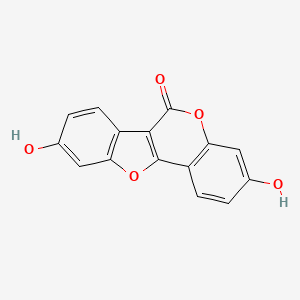| MeSH term | MeSH ID | Detail |
|---|---|---|
| Breast Neoplasms | D001943 | 24 associated lipids |
| Lupus Erythematosus, Systemic | D008180 | 43 associated lipids |
| Pancreatic Neoplasms | D010190 | 77 associated lipids |
| Colonic Neoplasms | D003110 | 161 associated lipids |
| Mammary Neoplasms, Experimental | D008325 | 67 associated lipids |
| Body Weight | D001835 | 333 associated lipids |
| Edema | D004487 | 152 associated lipids |
| Weight Gain | D015430 | 101 associated lipids |
| Endometriosis | D004715 | 29 associated lipids |
| Birth Weight | D001724 | 23 associated lipids |
COUMESTROL
COUMESTROL is a lipid of Polyketides (PK) class. Coumestrol is associated with abnormalities such as Infertility, Renal tubular disorder, Osteoporosis, Postmenopausal, Nodule and Central precocious puberty. The involved functions are known as Process, antagonists, Accident due to exposure to weather conditions, physiological aspects and Cell Proliferation. Coumestrol often locates in Blood, Body tissue, Reproductive system, Membrane and Myometrial. The associated genes with COUMESTROL are GAPDH gene, PPID gene, pyridinoline, NODAL gene and Nitrogen fixation gene. The related lipids are enterodiol. The related experimental models are Mouse Model.
Cross Reference
Introduction
To understand associated biological information of COUMESTROL, we collected biological information of abnormalities, associated pathways, cellular/molecular locations, biological functions, related genes/proteins, lipids and common seen animal/experimental models with organized paragraphs from literatures.
What diseases are associated with COUMESTROL?
COUMESTROL is suspected in Infertility, Renal tubular disorder, Osteoporosis, Postmenopausal, Nodule, Central precocious puberty and other diseases in descending order of the highest number of associated sentences.
Related references are mostly published in these journals:
| Disease | Cross reference | Weighted score | Related literature |
|---|
Possible diseases from mapped MeSH terms on references
We collected disease MeSH terms mapped to the references associated with COUMESTROL
PubChem Associated disorders and diseases
What pathways are associated with COUMESTROL
There are no associated biomedical information in the current reference collection.
PubChem Biomolecular Interactions and Pathways
Link to PubChem Biomolecular Interactions and PathwaysWhat cellular locations are associated with COUMESTROL?
Visualization in cellular structure
Associated locations are in red color. Not associated locations are in black.
Related references are published most in these journals:
| Location | Cross reference | Weighted score | Related literatures |
|---|
What functions are associated with COUMESTROL?
Related references are published most in these journals:
| Function | Cross reference | Weighted score | Related literatures |
|---|
What lipids are associated with COUMESTROL?
Related references are published most in these journals:
| Lipid concept | Cross reference | Weighted score | Related literatures |
|---|
What genes are associated with COUMESTROL?
Related references are published most in these journals:
| Gene | Cross reference | Weighted score | Related literatures |
|---|
What common seen animal models are associated with COUMESTROL?
Mouse Model
Mouse Model are used in the study 'Modulation of tumor formation and intestinal cell migration by estrogens in the Apc(Min/+) mouse model of colorectal cancer.' (Javid SH et al., 2005).
Related references are published most in these journals:
| Model | Cross reference | Weighted score | Related literatures |
|---|
NCBI Entrez Crosslinks
All references with COUMESTROL
Download all related citations| Authors | Title | Published | Journal | PubMed Link |
|---|---|---|---|---|
| Kruid J et al. | Unsubstituted metallophthalocyanine catalysts for the removal of endocrine disrupting compounds using HO as oxidant. | 2018 | Environ Sci Pollut Res Int | pmid:30229492 |
| Zhang T et al. | Quantitative structure-activity relationship for estrogenic flavonoids from Psoralea corylifolia. | 2018 | J Pharm Biomed Anal | pmid:30149188 |
| Zhang J et al. | Estrogen receptor-based fluorescence polarization assay for bisphenol analogues and molecular modeling study of their complexation mechanism. | 2018 | Anal. Chim. Acta | pmid:30143207 |
| Negi S et al. | Stable cellular models of nuclear receptor PXR for high-throughput evaluation of small molecules. | 2018 | Toxicol In Vitro | pmid:29933105 |
| Zhang J et al. | Estrogenicity of halogenated bisphenol A: in vitro and in silico investigations. | 2018 | Arch. Toxicol. | pmid:29152682 |
| Zafar A et al. | Deciphering the molecular mechanism underlying anticancer activity of coumestrol in triple-negative breast cancer cells. | 2018 | Toxicol In Vitro | pmid:28986287 |
| Koirala P et al. | Comparative Evaluation of the Antioxidant and Anti-Alzheimer's Disease Potential of Coumestrol and Puerarol Isolated from Pueraria lobata Using Molecular Modeling Studies. | 2018 | Molecules | pmid:29597336 |
| Silva EC et al. | Coumestrol Confers Partial Resistance in Soybean Plants Against Cercospora Leaf Blight. | 2018 | Phytopathology | pmid:29451417 |
| Reger MK et al. | Dietary intake of isoflavones and coumestrol and the risk of prostate cancer in the Prostate, Lung, Colorectal and Ovarian Cancer Screening Trial. | 2018 | Int. J. Cancer | pmid:29114854 |
| Argenta DF et al. | Topical Delivery of Coumestrol from Lipid Nanoemulsions Thickened with Hydroxyethylcellulose for Antiherpes Treatment. | 2018 | AAPS PharmSciTech | pmid:28681331 |
